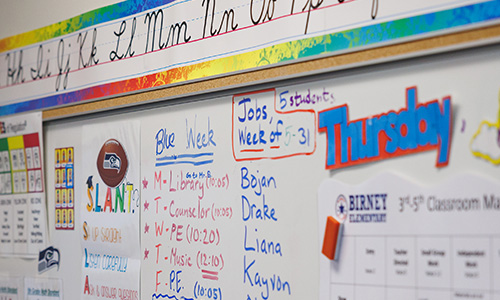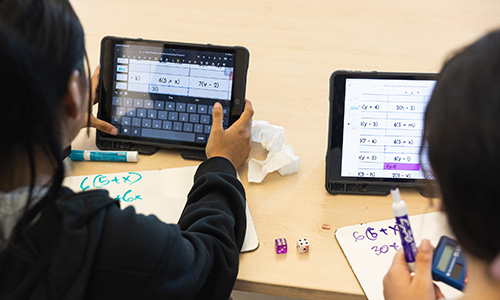
Growing up in the ’90s and early aughts, I wouldn’t have considered myself a “math person.” I was entrenched in the system of tracking, where students are placed in classes with students of like ability and then tiered by class number. The Ones, Twos, and Threes were the top-performing classes. Everyone else fell somewhere in the middle or below. My teachers didn’t seem to be encouraged to think about differentiation in the math classroom.
I was in one of those “top” classes, but despite my aptitude in ELA and social studies, I never failed to feel the cold chill of dread once our math notebooks hit our desks. My friends seated to the left and right of me (you may remember me mentioning that we were seated by last name) easily transitioned from one subject to the next. Yet there I was, stuck in the middle with math.
Many years later, we’ve seen the negative, limiting qualities of tracking. And while students are still occasionally grouped by similarities in ability, groups are now meant to be temporary and they’re just one of a variety of ways teachers can tailor instruction to provide all kids the optimal chance to be successful. That’s differentiated instruction in a nutshell.
Most of us tend to prefer subjects we’re good at. So when a student walks in your door and declares “I am not a math person,” what they’re really telling you is that no one has managed to find a way for them to feel successful in math—yet. I’m confident you can help them with differentiation.
My NWEA colleagues have heard me refer to my differentiation non-negotiables at length: 1. know your students, 2. become a content expert, and 3. embrace student assessment data. This is the triad of commitments I believe a teacher must make to reach the fullest expression of differentiation. Let’s dig into these together. I encourage you to set your sights on small shifts you can make in your practice and then work your way toward fully incorporating all three differentiation non-negotiables.
1. Know your students
The first step to highly effective differentiation in the math classroom is to know your students. This includes knowing basic facts about them, of course, like their name and how they’re doing in your class. But that isn’t enough. You need to also know their interests, preferences, areas of strength and focus, needs, and personalities. At NWEA, we refer to this as learner context—the “who” a student is, beyond surface information and numbers.
For many teachers, understanding their students well can be a real hurdle, despite the social nature of education. That can be partly because we fear what lies on the other side of our carefully implemented classroom management. Beyond our rational, intentional seating chart, bell-to-bell instruction, and choreographed conversations lies a world that may feel too chaotic for us to let in.
When we are able to take an interest in who our students are, we can begin to build trust, conversation, and collaboration, and I find that these things can create the opposite of chaos; they can create harmony. Knowing a student cares for a younger sibling, for example, or that they play a sport or an instrument and have a preferred learning style can help you color in the complete picture of who they are as a person, not just who they are as a student.
Toward the end of my time in the classroom, I had one student who was particularly challenging. She was readily defensive, pushed the limits of our school’s policies, and shrugged off poor grades with a projected indifference. Instead of fighting fire with fire, I decided to chat with her one day over pizza. She told me her parents were going through a divorce and that she was mad all the time. She didn’t care what was happening in school because, to her, everything was meaningless chaos. I sat and listened and realized that there was potential buried deep beneath all of her hurt. From that moment on, I built upon that interaction to create an environment where she felt more trust, understanding, and collaboration so she could bring her best self to my math classroom.
I believe one of the largest problems math teachers in particular face is not necessarily the complexity of the content but the negative dispositions to learning that create barriers to success. Building a meaningful relationship with that troubled student really helped me support her in feeling more positive about learning. Getting to know your students could help you have similar successes, and it could also create opportunities for you to work what you know about them into your differentiation techniques. Incorporate as many opportunities as possible for your students to bring their interests to discussions. Let your more creative students shine via artistic interpretations of word problems. Encourage your linguistically talented students to feel empowered by connecting algebra language to sentence structure. Get those athletes involved through dynamic station rotations or timed team activities.
2. Become a content expert
The next step—after you’ve peeled back the layers, broken the fourth wall, embraced the mess, and created trust—is to become an expert in your content area. Easier said than done.
If you’re an elementary teacher, I can hear your collective sigh, as this means you need to be an expert in most subjects, which is a tremendous lift. To clarify: When I say “expert,” I’m not saying I expect you to crack the Enigma code or write the next great American novel (but heck, yeah, if you want to!). What I mean is that you have to possess a fullness of understanding of your content to be able to anticipate next steps, understand what the trajectory of success looks like for that subject, and pivot within every lesson with confidence.
To maximize differentiation, you should be fluent in the scope and sequence of your content, both its depth and breadth. Knowing what precedes and succeeds your topic, unit, and standard allows you to scaffold for access to grade-level content or for challenge extension as needed. I’m a former middle school math teacher, and while I didn’t teach all grades at once, I had an awareness of the evolution of the standards from one grade to the next. This helped me when creating scaffolded supports (like tiered worksheets), creating intentional student groups to foster robust discussion, and having additional support at the ready to infuse into a discussion as needed.
When you are confident in your content area, students are also more inclined to follow you on a learning journey because they trust you know the way. Tasks, lessons, and discussions have more meaning when there is a sense of intentionality behind them. Confidence in your content area can help you feel a greater sense of pride in your work, too.
3. Embrace student assessment data
Student assessment data is one of the sharpest tools in any teacher planning and differentiation toolkit.
A lot of the power of assessment can lie beyond the test. Sometimes we fall into the habit of labeling assessment as either “formative” or “summative,” and while there’s value in knowing its purpose, I encourage you to go beyond that. You’re constantly absorbing information related to an assessment that can be used to make decisions. Consider a student with several responses left blank during independent practice or a student who is quiet during a paired activity. That’s observational data, and your observations matter, especially when you pair what you see with numerical data to inform instruction.
The National Council of Teachers of Mathematics encourages us—and our students—to reflect on learning. I encourage you to regularly consult assessment data and your observations of students because doing so can better help you offer them targeted support. The data should sit alongside your scope and sequence or unit plan as you are creating your lessons. Consider assessment data from tests like MAP® Growth™ and also the data that comes from exit tickets, timed entrance tasks, conference notes, observations during whole group independent work, midterm exams, pop-quizzes, and more when making decisions about resources, groupings, and lesson objectives.
Differentiation in the math classroom should be a habit
Whether you’re a beginner exploring differentiation for the first time or a multitasking expert eager to explore new ideas, differentiation is a lifelong skill worth working on. It’s not unlike moderate exercise, eating healthy, and mindfulness: any negative side effects are usually negligible and the benefits far outweigh them.
I find that the more teachers embrace differentiation, the more confident they will feel and the more inspired their lessons will be. Eventually, it will all become a habitual best practice and manifest seamlessly and instinctually in your planning, instead of feeling like an overwhelming must-do.






